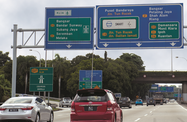New infrastructure investment will help bolster Sabah’s efforts to position itself as a logistics and trans-shipment hub for the Brunei Darussalam-Indonesia-Malaysia-Philippines East ASEAN Growth Area and beyond – as well as support further developments in industry, trade and tourism.
In mid-February Suria Capital told local media that its subsidiary, Sabah Ports, had been tasked with heading up an extensive expansion for the Sepanggar Bay Container Port (SBCP).
This expansion is a key component of the 11th Malaysia Plan for 2016-20 (11MP) – the most recent of the government’s five-year development programmes – and the third phase of the Sabah Development Corridor (SDC), which is being rolled out under the Sabah Economic Development and Investment Authority (SEDIA).
Container-handling capacity
The project, set to break ground in 2017 and reach completion in 2019, anticipates an increase in the length of vessel berths from 500 to 1200 metres and a quadrupling of container-stacking areas from 15 to 60 ha.
This expansion will more than double the port’s container throughput, from 500,000 to 1.25m twenty-foot equivalent units (TEUs) per annum.
Around RM800m ($197m) of the funding will come from the 11MP budget, staggered over 2016 and 2017. This forms part of a broader RM2.4bn ($591.1m) package of funding for SDC projects.
While SBCP currently handles an average of 300,000 TEUs per year – equivalent to around 70% of Sabah’s total container movements – demand is rising steadily; movements have grown by 5-6% per annum since the port opened in 2006.
In addition to increasing cargo handling, the expansion will allow SBCP to accommodate larger ships, including Panamax-size vessels. This should help attract mainline operators to the port, thereby boosting Sabah’s appeal as a trans-shipment centre and solidifying its global logistics links.
“The SBCP expansion is viewed as a game changer for the transformation of Kota Kinabalu city,” Mohd Yaakub Johari, president and chief executive of SEDIA, told OBG.
Investment driver
While Sabah’s potential as a trans-shipment hub is strong, further investment will be needed to expand its industrial capacity and export volumes, according to Chow Yang Ann, managing director of the freight-forwarding and logistics firm Standard Marine and president of the Sabah Shipping Agents Association.
“For Sabah to become a successful trans-shipment hub, the state needs to further develop its supporting industries and capability to ensure it stands out from other potential hubs in the region,” he told OBG.
The SBCP expansion could serve as a catalyst to fuel the industrial growth needed to boost Sabah into the ranks of regional trans-shipment centres.
Melvin Disimond, CEO of the state-owned Kota Kinabalu Industrial Park (KKIP) in Sabah, sees the port project as one of the last pieces in the puzzle for establishing Sabah as an investment platform.
“With the expansion of the port we will be addressing concerns about the cost of doing business,” Disimond told OBG. “In enhancing the port and its accompanying facilities we expect to see the speed and cost of imports and exports to be improved significantly.”
As these enhanced operational and cost efficiencies help attract further investment to Sabah, KKIP will be looking to develop value-added capacity to process materials coming through the port, Disimond added.
Policy avenues
Proposed amendments to the 1980 National Cabotage Policy (NCP), which requires that all domestic shipping trade be conducted in Malaysian-owned vessels, could offer further growth prospects.
Under the NCP, most imported cargoes destined for the domestic market have to be trans-shipped at Malaysia’s main maritime gateway, Port Klang, rather than being carried directly to their destination in foreign hulls.
There have been calls from trade and industry groups in Sabah for the NCP to be scrapped – or at least scaled back – in order to boost maritime activity in the state’s ports and improve logistics efficiencies.
One proposal, offered by Wong Khen Thau, honorary life president of the Federation of Sabah Industries (FSI), was to designate SBCP as a national trans-shipment hub, giving it a status similar to Port Klang.
“As international trade continues to grow there will be plenty to justify the dual gateway policy, with Port Klang covering the western hemisphere and Sabah covering the east – namely China, Taiwan, Japan and South Korea,” Yap Cheen Boon, vice-president of the FSI, told OBG. “Positioning Sabah as a trading hub could jumpstart the economy.”
Tourism and aviation payoffs
The SBCP expansion is also set to offer carry-through benefits to other sectors at the heart of Sabah’s development, including tourism.
When announcing upgrades to the port in February, Joseph Pairin Kitingan, deputy chief minister of Sabah and minister of infrastructure development, said the expansion was expected to drive visitor growth.
“Cruise ships are now an uptrend,” he told local media. “Once our port facilities are expanded, we shall include the capacity to welcome all of these cruise ships. This will help to contribute towards the increase in tourists coming into Sabah.”
These efforts should receive further support from planned infrastructure investments being rolling out in the coming years.
An RM80m ($19.7m) expansion of the Kota Kinabalu International Airport (KKIA) apron and terminal was announced at the beginning of March, with 10 additional overnight aircraft parking bays on the cards.
Malaysia Airports Holdings, the airport operator, aims to increase KKIA’s passenger-handling capacity from 9m to 16m people over the next five years.
The 11MP also earmarks funding for a study to develop a master plan to create an aviation and airfreight logistics hub in Sabah. If implemented, this could both provide a boost for the tourism industry, while also expanding shipping connectivity, adding a further spoke to Sabah’s efforts to position itself as an integrated freight and logistics centre.
Oxford Business Group is now on Instagram. Follow us here for news and stunning imagery from the more than 30 markets we cover.

